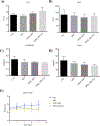pH-responsive and folate-coated liposomes encapsulating irinotecan as an alternative to improve efficacy of colorectal cancer treatment
- PMID: 34634556
- PMCID: PMC9052206
- DOI: 10.1016/j.biopha.2021.112317
pH-responsive and folate-coated liposomes encapsulating irinotecan as an alternative to improve efficacy of colorectal cancer treatment
Abstract
Irinotecan (IRN) is a semisynthetic derivative of camptothecin that acts as a topoisomerase I inhibitor. IRN is used worldwide for the treatment of several types of cancer, including colorectal cancer, however its use can lead to serious adverse effects, as diarrhea and myelosuppression. Liposomes are widely used as drug delivery systems that can improve chemotherapeutic activity and decrease side effects. Liposomes can also be pH-sensitive to release its content preferentially in acidic environments, like tumors, and be surface-functionalized for targeting purposes. Herein, we developed a folate-coated pH-sensitive liposome as a drug delivery system for IRN to reach improved tumor therapy without potential adverse events. Liposomes were prepared containing IRN and characterized for particle size, polydispersity index, zeta potential, concentration, encapsulation, cellular uptake, and release profile. Antitumor activity was investigated in a murine model of colorectal cancer, and its toxicity was evaluated by hematological/biochemical tests and histological analysis of main organs. The results showed vesicles smaller than 200 nm with little dispersion, a surface charge close to neutral, and high encapsulation rate of over 90%. The system demonstrated prolonged and sustained release in pH-dependent manner with high intracellular drug delivery capacity. Importantly, the folate-coated pH-sensitive formulation had significantly better antitumor activity than the pH-dependent system only or the free drug. Tumor tissue of IRN-containing groups presented large areas of necrosis. Furthermore, no evidence of systemic toxicity was found for the groups investigated. Thus, our developed nanodrug IRN delivery system can potentially be an alternative to conventional colorectal cancer treatment.
Keywords: Antitumor activity; Folate-coated; Irinotecan, polyethylene glycol; Liposomes.
Copyright © 2021 The Authors. Published by Elsevier Masson SAS.. All rights reserved.
Conflict of interest statement
Conflict of interest statement
The authors declare they have no conflict of interest.
Figures






Similar articles
-
Dual-pH Sensitive Charge-Reversal Drug Delivery System for Highly Precise and Penetrative Chemotherapy.Pharm Res. 2020 Jul 8;37(7):134. doi: 10.1007/s11095-020-02852-6. Pharm Res. 2020. PMID: 32642819
-
PEG-coated irinotecan cationic liposomes improve the therapeutic efficacy of breast cancer in animals.Eur Rev Med Pharmacol Sci. 2013 Dec;17(24):3347-61. Eur Rev Med Pharmacol Sci. 2013. PMID: 24379067
-
Biomimetic modification of macrophage membrane-coated prussian blue nanoparticles loaded with SN-38 to treat colorectal cancer by photothermal-chemotherapy.Drug Deliv Transl Res. 2025 May;15(5):1525-1539. doi: 10.1007/s13346-024-01689-5. Epub 2024 Sep 9. Drug Deliv Transl Res. 2025. PMID: 39251553
-
Elucidating the role of pharmacogenetics in irinotecan efficacy and adverse events in metastatic colorectal cancer patients.Expert Opin Drug Metab Toxicol. 2021 Oct;17(10):1157-1163. doi: 10.1080/17425255.2021.1974397. Epub 2021 Sep 6. Expert Opin Drug Metab Toxicol. 2021. PMID: 34486919 Review.
-
Enzyme-responsive liposomes for controlled drug release.Drug Discov Today. 2024 Jul;29(7):104014. doi: 10.1016/j.drudis.2024.104014. Epub 2024 May 3. Drug Discov Today. 2024. PMID: 38705509 Review.
Cited by
-
Innovative Nanoparticulate Strategies in Colon Cancer Treatment: A Paradigm Shift.AAPS PharmSciTech. 2024 Mar 1;25(3):52. doi: 10.1208/s12249-024-02759-0. AAPS PharmSciTech. 2024. PMID: 38429601 Review.
-
The Nanotech Potential of Curcumin in Pharmaceuticals: An Overview.Curr Drug Discov Technol. 2024;21(2):e260723219113. doi: 10.2174/1570163820666230726125809. Curr Drug Discov Technol. 2024. PMID: 37493163 Review.
-
Evaluation of acute toxicity and in vitro antitumor activity of a novel doxorubicin-loaded folate-coated pH-sensitive liposome.Biomed Pharmacother. 2023 Sep;165:115280. doi: 10.1016/j.biopha.2023.115280. Epub 2023 Aug 2. Biomed Pharmacother. 2023. PMID: 37541172 Free PMC article.
-
Developments in nanotechnology approaches for the treatment of solid tumors.Exp Hematol Oncol. 2025 May 19;14(1):76. doi: 10.1186/s40164-025-00656-1. Exp Hematol Oncol. 2025. PMID: 40390104 Free PMC article. Review.
-
Irinotecan-Loaded Polymeric Micelles as a Promising Alternative to Enhance Antitumor Efficacy in Colorectal Cancer Therapy.Polymers (Basel). 2022 Nov 14;14(22):4905. doi: 10.3390/polym14224905. Polymers (Basel). 2022. PMID: 36433032 Free PMC article.
References
-
- Wei H, Song J, Li H, Li Y, Zhu S, Zhou X, Zhang X, Yang L, ScienceDirect Active loading liposomal irinotecan hydrochloride: preparation, in vitro and in vivo evaluation, Asian J. Pharm. Sci. 8 (2013) 303–311, 10.1016/j.ajps.2013.10.006. - DOI
Publication types
MeSH terms
Substances
Grants and funding
LinkOut - more resources
Full Text Sources
Medical

